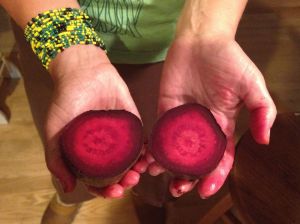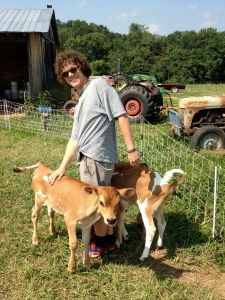Energetic Food
by jwingwilson
Our Jamaican friend, Phyllis, told a story about her friend, visiting from the Island, who looked at a chicken they had bought in the Bronx and said, “How can you eat that dead chicken?” Hopefully all chickens have passed on by the time we cook them, but what she meant was the mass-produced chicken was energetically dead; there was no life energy in it.
Her story has come home to us as we start our second year of a year-round, full-diet CSA that puts truly energetic food on our table every week. We have tried to eat “real food” (thank you, M. Pollan) for a while. Choosing organic over no name, frequenting the local farmers’ markets, and opting for fresh over processed whenever we can. It’s been more expensive, some times more hassle but our attempt to rid ourselves of chemicals and other unwanted shadows of our modern, mass-produced food without farming ourselves has been a bit of a quest. While it’s not always easy to tell and labeling is not what it ought to be, nonetheless we were trying to reduce energy waste and pollutants to others and ourselves.
But it wasn’t until we signed on with Rob Moutoux that we realized what we were missing. Rob runs his family farm in Purceville, VA, with his girl friend Mo and, until recently, the best two farm hands ever, Rochelle and Jessi. He also gets help from his folks, life-long small farmers in Northern Virginia. Rob is a bold and determined man. His vision is to provide nearly all the food that 70 people need, year round. His goal is to run, as close as he can, a chemical free, integrated farm that produces milk, eggs, meat, and veggies following the season, with help from hoop houses and lots of crop and animal rotations. Starting his third year, with a lot of hard work, it seems to be working. While he has had to train us all on how to preserve when there’s abundance and substitute when there’s not (did I ever imagine there were so many types of beets, or you can “massage” kale to make a great winter salad or that turnips can be flashed cooked and included in almost anything for a wonderful nutty flavor?). The weekly pickups become a foodie’s dream, as we chat about what weird vegetable has appeared and everyone’s’ favorite way to cook it, how to make instant kimchi, or what happens to mustard greens when you sauté them and add them to scrambled eggs.
Ok, I digress. What about the energy?
The weird and completely unexpected thing is that there is a quality to this food that makes everything we’ve ever eaten dead in comparison. I imagine if you turned out the lights, the food in his barn would glow in the dark, or maybe you could hear the veggies talking to each other about how excited they were to be added to the Willies’ stew or stir-fry in the next few days. So there are some weird things about this energetic, alive food. While even the best Whole Foods organic spring mix, or even greens from most of the local farmers’ markets, might last a few days, with luck a week with refrigeration, this stuff lasts two or three times as long. The garlic, which can also last for weeks, has a kick and flavor to it that no other I have ever tasted even comes close to. When the food is cooked, the colors are amazing (doesn’t hurt that there are several different color carrots, orange, white and purple ones, and some beets that are white with pin stripes all through them.) And I swear we eat less. We get just MORE from whatever we eat. Even the meats and chickens, while frozen to keep them after some Amish guy has butchered them, have a taste and texture that my Jamaican friends would admire. They are alive!!
So how come? Of course, the food is really fresh. Rob and his gang pick it minutes before our pick up and they store the root vegetables carefully. Also, they take great care with the milk and hand make yogurt and cheese when the cows are happily pumping out a good supply. And it’s definitely his hard work and diligently studied farming methods, which depend on little things like animals to fertilize and turn the soil, chickens to eat the bugs and careful rotation to keep the land healthy. Maybe it’s the proximity to the beautiful Shenandoah Mountains. I have to think, above all, it’s the love. They love the dirt, the weather, the little seeds that turn into beautiful vegetables and the joy on our faces as we haul away the bounty. I tell you the energy is tangible. It talks to me!
I don’t know if the energy is measurable, but we plan to go on eating whatever the Moutoux Orchard can produce. I just wonder how we can get energy back into more food for more people. Clearly they can still get “live” chickens in Jamaica, where the farms are close to the people and the chickens scratch in the dirt for bugs. Our Jamaican friends have continued to do something right and I aint talking about adding Jerk Sauce (although that can’t hurt!). Maybe, as the cost of fossil fuel rises and people start to see and taste real food again, we can put the right kind of energy on our tables and less into the sky. Eat one of Rob’s apples, spots and all, or a fresh carrot just yanked from that healthy soil and everyone would sign on to that renewable plan!

